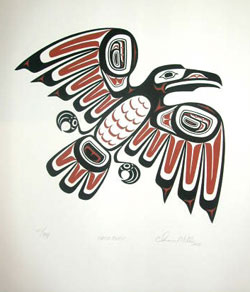Haidian
The island of Haida Gwaii (Queen Charlotte Island) is home to the Haidian speakers. The Haidian language has two dialects, Haida and Haisla.
Haidian speakers recognised matrilineal lineage. Two social units were observed. The first was the Raven with twenty-two lineages and the second was the Eagle with twenty-three lineages. Lineage offered the right to perform myths, legends, dances, songs, and music. Names were highly coveted lineage property that was given away at potlatch ceremonies. To the Haidian peoples potlatches served a religious function, but they were mainly a political, economic, and social gathering. Highly valued objects such as canoes, carved and painted chests, and furnishings are examples of handicrafts given during potlatch. Sculpture, totem poles, and carved handles of horn spoons were decorated with clan motifs. Potlatch was given for marriages, deaths, and the giving of names. Gifts were distributed to guests to pay them for witnessing the events. This system of witnessing was a method of recording the complex exchanges, settling of debts, and other official acts. The clan chief distributed gifts with the request that the guests pay close attention to a transaction and bear witness. Gifts of the greatest significance were copper, which was given to humiliate rival chiefs who were unable to return a gift of equal value. To demonstrate power the chief may burn blankets or smash potlatch goods. His ability to disregard the value of these goods demonstrated his great wealth.
 Religious belief systems involved a hierarchy of divinities. The Raven gave the Haidian their culture and taught them to use natural resources, and the Orca controlled the main sources of food, which came from the ocean. The lower ranking spirits, who derived their powers from the principal spirits, were more directly involved with humans. Shamans, men, and women, usually from high-ranking families, were entrusted as intermediaries with the spirit world. Shamans were very careful in their observance of prayer and fasting, and they distinguished themselves by dressing differently from the rest of clan.
Religious belief systems involved a hierarchy of divinities. The Raven gave the Haidian their culture and taught them to use natural resources, and the Orca controlled the main sources of food, which came from the ocean. The lower ranking spirits, who derived their powers from the principal spirits, were more directly involved with humans. Shamans, men, and women, usually from high-ranking families, were entrusted as intermediaries with the spirit world. Shamans were very careful in their observance of prayer and fasting, and they distinguished themselves by dressing differently from the rest of clan.